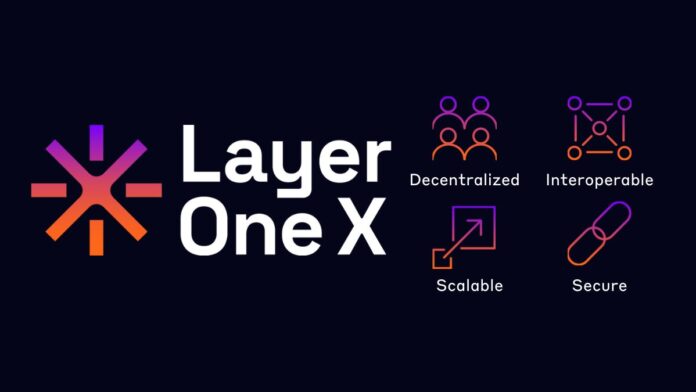Last Friday, Layer One X (L1X) announced a landmark development in the blockchain space by becoming the first layer one blockchain to achieve a decentralized transfer of assets between an EVM chain and a Non-EVM chain. This achievement allows the fast, secure and decentralized transfer of assets between blockchains without the use of bridges. The latest achievement was launched on the Layer One X testnet and will be fully launched once the mainnet is unveiled in August this year.
Layer One X is a new layer 1 blockchain, currently in testnet, that aims to revolutionize decentralized cross-chain asset transfer. According to its website, the platform delivers the ‘Blockchain quartet’ of “interoperability, decentralization, scalability, and security” without compromising one over the other. The latest development, allowing interoperability between EVM and non-EVM chains, is a game-changer for blockchain users and developers, as it removes the need to use bridges.
Speaking on the successful test, Layer One X Founder Kevin Coutinho believes the development will drastically alter the ease of asset transfer across the broader blockchain ecosystem.
“We are excited for the opportunity this presents to allow projects and developers to build asynchronous features on blockchains through a decentralized source of truth,” he said.
Simply, EVM chain refers to blockchain networks that are compatible with Ethereum Virtual Network (EVM), such as Polygon, Binance Smart Chain (BSC), and Ethereum itself. On the other hand, non-EVM chains are not compatible with the Ethereum Virtual Machine and do not share the same programming languages. Some examples of non-EVM chains include Solana, Polkadot & Cosmos. Since the advent of blockchains, transferring assets between EVM and non-EVM chains has been a challenge.
As the decentralized finance ecosystem grows, the safety and security of decentralized cross-chain asset transfers becomes more and more critical. The most significant advantage that L1X brings to users is removing the need for bridges to transfer assets across blockchains. In 2022, of the $2 billion hacked from DeFi protocols, $1.6 billion was associated with bridges including Wormhole, Ronin bridge, Nomad and Wintermute. Crucially, bridges are soft targets for hackers hence the need for safer and more secure solutions. Finally, bridges are often expensive and complex solutions for cross-chain asset transfers.
Apart from replacing bridges, L1X also allows the development of more interoperable DeFi solutions. The connectivity of EVM and non-EVM chains will enable developers to build DApps that work seamlessly across different blockchain networks, giving them access to a larger pool of assets. This means that decentralized applications will have more choices of assets, enhancing capital provision and efficiency.
L1X shaping the future of blockchain interoperability
Layer One X’s latest innovation aims to shape the future of blockchain asset transfers and the DeFi ecosystem. This new paradigm of blockchain interoperability is expected to drive increased adoption and offer additional value for users and blockchain-based businesses.
“We are now focused on bringing generic messaging and event-based interoperability with the same virtual machine in the coming few months that will open markets such as decentralized identification and multi-chain utility,” Coutinho added.
As interoperability across EVM and non-EVM chains become more scalable, users will be able to open up new business models and earning streams quickly and efficiently. The combination of these factors will help increase the adoption of blockchain technology by making it more accessible and easier for developers and end-users.
Disclaimer: This article is provided for informational purposes only. It is not offered or intended to be used as legal, tax, investment, financial, or other advice.
Credit: Source link






















 Bitcoin
Bitcoin  Ethereum
Ethereum  Tether
Tether  XRP
XRP  Solana
Solana  Dogecoin
Dogecoin  USDC
USDC  Lido Staked Ether
Lido Staked Ether  Cardano
Cardano  TRON
TRON  Avalanche
Avalanche  Toncoin
Toncoin  Wrapped stETH
Wrapped stETH  Chainlink
Chainlink  Shiba Inu
Shiba Inu  Wrapped Bitcoin
Wrapped Bitcoin  Sui
Sui  Hedera
Hedera  WETH
WETH  Polkadot
Polkadot  Stellar
Stellar  Hyperliquid
Hyperliquid  Bitcoin Cash
Bitcoin Cash  LEO Token
LEO Token  Uniswap
Uniswap  Pepe
Pepe  Litecoin
Litecoin  Wrapped eETH
Wrapped eETH  Ethena USDe
Ethena USDe  NEAR Protocol
NEAR Protocol  USDS
USDS  Aave
Aave  Aptos
Aptos  Internet Computer
Internet Computer  Mantle
Mantle  Cronos
Cronos  POL (ex-MATIC)
POL (ex-MATIC)  Ethereum Classic
Ethereum Classic  WhiteBIT Coin
WhiteBIT Coin  Monero
Monero  Render
Render  MANTRA
MANTRA  Dai
Dai  Virtuals Protocol
Virtuals Protocol  Bittensor
Bittensor  Artificial Superintelligence Alliance
Artificial Superintelligence Alliance  Arbitrum
Arbitrum 
